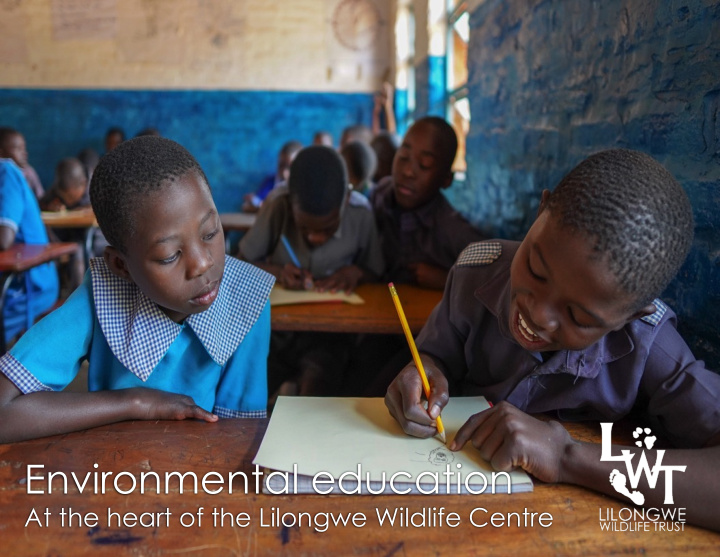



Environmental education At the heart of the Lilongwe Wildlife Centre
About the Lilongwe Wildlife Centre The Lilongwe Wildlife Centre (LWC) is Malawi’s only wildlife rescue facility. Set in a beautiful 180-hectare reserve in the heart of the capital, Lilongwe, LWC is the city’s most prominent natural green space and a critical part of Lilongwe’s unique cultural history and increasingly fragile biodiversity. Established in 2008 | Supports approximately 200 animals at any one time World renowned for high welfare standards | PASA and GFAS accredited
Preserving the Lilongwe Wildlife Centre A decade after it was established, the Lilongwe Wildlife Centre is in urgent need of protection. The city of Lilongwe is growing rapidly and its green spaces are under threat from urban encroachment and deforestation. Many have already been destroyed. In recent years, deforestation and urban build-up within the city, coupled with climate change, has caused increased frequency of flooding along the Lingadzi River that runs through the centre site. This has caused significant damage to infrastructure.
2020 redevelopment strategy EDUCATION ANIMAL WELFARE SUSTAINABILITY VISITOR EXPERIENCE Goal: Goal: Goal: Goal: Increase animal Ensure LWC is Establish LWC as Turn LWC into a welfare standards by Lilongwe’s premier a beacon of gold-standard improving the animal destination for environmental educational facility clinic, enclosures, recreation, education sustainability in to inspire Malawi’s quarantine and and engagement Malawi. next generation of orphan care facilities. with nature. conservationists.
Redevelopment projects Volunteer Visitor hub Rescue housing centre and sanctuary Clinic and Educational Sustainable quarantine facilities strategies
PUTTING ENVIRONMENTAL EDUCATION AT THE HEART OF LWC
Why environmental education? Malawi is facing a number of serious environmental crises, from deforestation and pollution to the illegal trade in wildlife products. 50% of the country’s forests have • been lost over the last 40 years 60% of land is affected by soil • erosion Poaching causes annual economic • losses of USD 8.4 million By inspiring and empowering people to safeguard their natural heritage we can stem this cycle of decline.
Inspiring the next generati on The LWC is uniquely positioned to act as the country’s leading facility for conservation education, inspiring Malawi’s next generation to safeguard its wild animals and habitats. Since it launched in 2009, our environmental education programme has reached over 175,000 children across Malawi.
Our vision We have developed an ambitious plan to create a pioneering ‘education zone’ at the heart of the Lilongwe Wildlife Centre. The cornerstone of this zone will be a new, state-of-the-art education centre that will serve as the country’s leading facility for environmental education. The aim is to inspire children to value and protect their natural heritage for future generations.
Education zone
Educational elements A diverse programme of classes, exhibitions and activities A trail system offering interactive educational opportunities throughout the site An elevated boardwalk to replace the existing playground, which will allow children to engage more closely with nature and minimize the impact on their surroundings An outdoor amphitheatre to aid in the teaching of outdoor classes or showing performances or talks Others TBC … .
How can you help? There are a number of ways you could support us: Make a donation either • individually or through your company Provide in-kind support e.g. • building materials, technical assistance etc. Introduce us to a potential • supporter If you would like to be part of this exciting project please get in touch with our Centre Manager, Ian D’heygere, on ian@lilongwewildlife.org.
OTHER REDEVELOPMENT PROJECTS
Animal care Animal care Changes to the rescue centre are all based on the main objective of improving animal welfare § Improved enclosures, clinic, quarantine and orphan care to improve quality of life for animals § Relocation of education centre will reduce disturbance of animals and diminish interaction between large school groups and other visitors § Transfer of all sanctuary animals to form a strip running parallel to the main trail, meaning no visitors will come near the rescue animals § Less interaction with rescue animals will lead to more successful releases § Future enclosures have been allocated and can be developed based on future demand
Volunteer housing & visitor hub Volunteers & visitors VOLUNTEER HOUSING § Renovation for comfort and a clearer separation of accommodation and work spaces § Ventilation improvements to reduce the need for electrical cooling systems VISITOR HUB § Visitor hub will include: - Botanic garden - Educational boardwalk - Bridges - Improved trails with opportunity for cycling - Canopy walk § Parking capacity increased from 20 to 60 spaces
Building capacity Building capacity Our high quality volunteer and internship programmes attract numerous vets and vet students each year. A new state-of-the-art veterinary clinic will allow a solid partnership with LUANAR, with increased capacity to allow more educational activities. New and improved clinic facilities will enable us to build the capacity of local and international students and train veterinarians who can be employed by DNPW.
Sustainable strategies Sustainability Sustainability will be a guiding principle throughout the redevelopment process § The choice of materials will focus on use of rammed earth, soil stabilised blocks and improved air circulation and lighting to diminish energy requirements § Sustainable strategies include: - Elimination of inefficient energy and water systems - Hybridisation of spaces - Minimisation of landscape disturbance - Zero net energy building - Adaptive re-use of existing buildings
Thank you
Recommend
More recommend